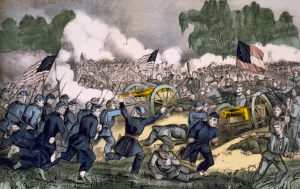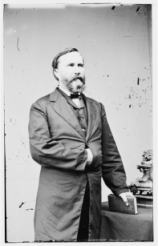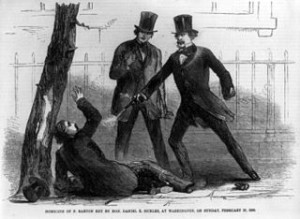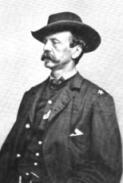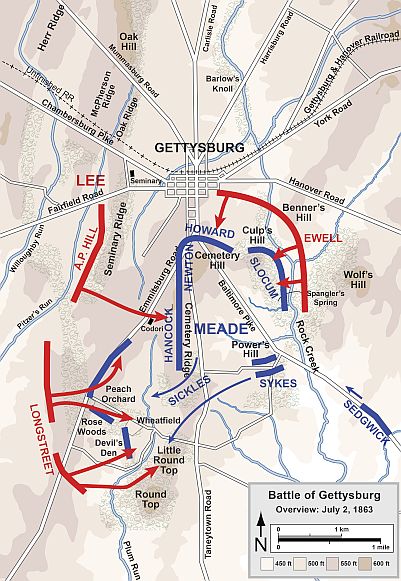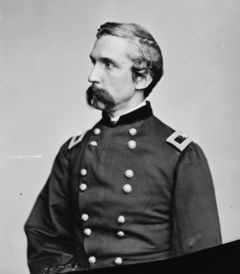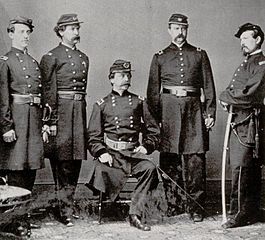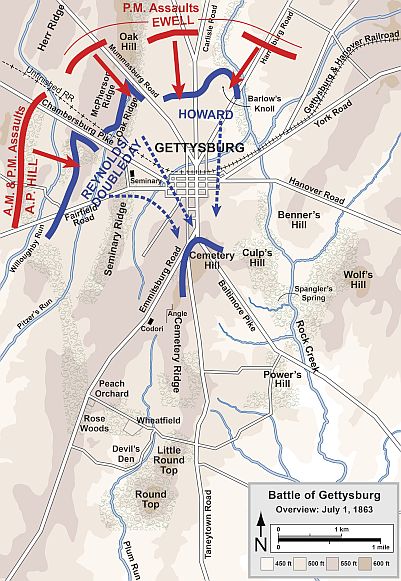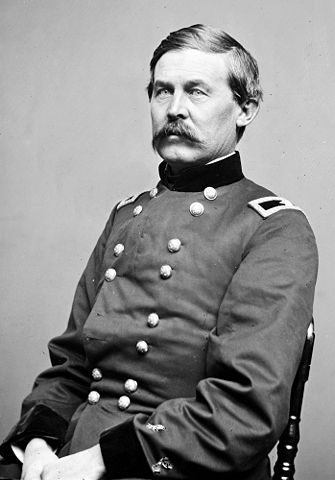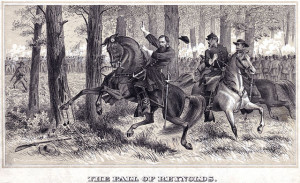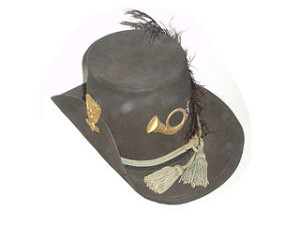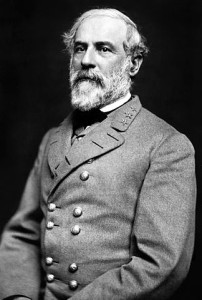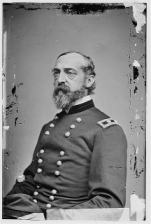“The Enemy Is There, And I Am Going To Attack Him There”
July 2, 1863
During the night of July 1, the Confederate and Union armies continued to arrive at the crossroads town of Gettysburg.
As dawn came on July 2, approximately 65,000 Rebels and 85,000 Yankees faced each other over Gettysburg’s terrain. The Union held the high ground with a fishhook-shaped line stretching along Cemetery Ridge. At each end of the Union line there were hills. Culp’s Hill and Cemetery Hill on the right end, Little Round Top and Big Round Top on the left.
Confederate General Robert E. Lee wanted the high ground taken from the Federals. In a discussion with his “Old War Horse” General James Longstreet, Lee explained as he pointed towards Cemetery Hill:
“The enemy is there, and I am going to attack him there.”
James Longstreet Disagrees With Lee’s Plan
James Longstreet had doubts about attacking the Yankees at Gettysburg on the second day. Longstreet did not think attacking the enemy on their high ground was the wisest thing to do. “Old War Horse” James Longstreet preferred another plan.Longstreet’s idea was for the Army of Northern Virginia to turn the Union’s south flank and position itself between the Army of the Potomac and Washington. Longstreet’s plan would compel General Meade and his troops to attack on ground chosen by the Confederates to their advantage. Longstreet thought the tactical defensive position was best, but General Lee preferred aggressive offensive movements. The Army of Northern Virginia would follow General Robert E. Lee’s plan, not Longstreet’s.
This is one of the great questions for debate of the Civil War… what if the Confederates had followed Longstreet’s plan instead of Lee’s on the second day of battle at Gettysburg?
Lee’s strategy was for Longstreet to attack the Union’s left flank at Little Round Top and Big Round Top. Meade would have to send troops to the left flank to answer Longstreet’s attack. General Ewell would attack the Union right flank at Culp’s Hill. If this plan worked, the Confederates would overtake both of the Union flanks, gain the high ground, and win the battle… and maybe the war.
Lee wanted Longstreet to begin his attack as soon as possible on the morning of July 2. Due to various reasons (In light of Longstreet’s disagreement with Lee over the Gettysburg battle plans, some historians question Longstreet’s diligence in proceeding with his attack on the Union left flank, that perhaps Longstreet was purposely stalling. This is speculation, and there are factors that should be studied carefully before this conclusion is made. This is a fun topic of debate for Civil War students.) Longstreet did not have his troops into position until 4:00 in the afternoon.
Part of the problem Longstreet had getting his men into position, was that the Yankees were not where they were supposed to be on their left flank. Union General Dan Sickles and the 3rd Corps were supposed to be in position to hold the Union left flank.
Dan Sickles
Dan Sickles is an interesting character and he deserves some attention.
Before the Civil War, Daniel Edgar Sickles was a lawyer and a legislator. From 1853 to 1855 he served as President Franklin Pierce’s London Legation (at the time, the United States did not yet have formal embassies). Sickles was elected to the New York Senate, then served as a Democrat in the United States Congress from 1857 to 1861.In 1859 while serving in the United States Congress, Dan Sickles shot and killed Philip Barton Key at LaFayette Park, which was located across the street from Sickles’ home and the White House. Key was having an affair with Mrs. Sickles, so Sickles killed him. Philip Barton Key was the son of Francis Scott Key, the composer of “The Star Spangled Banner”.
Temporary Insanity
For the following trial, Sickles chose Edwin Stanton as his defense attorney (Stanton would later serve as Abraham Lincoln’s Secretary of War). Stanton used a unique and new tactic to defend Sickles. Stanton claimed Sickles was innocent of murder because he was temporarily insane when he killed his wife’s lover. The jury agreed and Congressman Sickles was found innocent.
After killing her paramour, Sickles publicly forgave his wife and took her back. This outraged the public. It seems the public understood the business of an outraged husband shooting and killing his cheating wife’s lover (Sickles had the public’s understanding and sympathy during all this drama), but for the husband to then forgive his wife and take her back, well, that was just too much for people to stomach in 19th century America. With the loss of voter support, Sickles’ political career ended.
At the start of the Civil War, Dan Sickles saw opportunity and a fresh start for himself. After all, there is nothing like a war to help turn your life around.Sickles raised the Excelsior Brigade of New York City and later in June of 1861, he was commissioned as Colonel Sickles of the 20th New York. The politician Sickles new military career was now successfully underway. Perhaps the former congressman (and also formally temporarily insane) Dan Sickles went off to war humming the “The Star Spangled Banner” to himself… fighting as he was to save the Union. Nevertheless, Sickles was now back on both of his feet. Would he be able to hang onto both of the legs those feet were attached to?
On July 2, 1863, Dan Sickles was at Gettysburg as the General of the 3rd Corps. As fate would have it, it was Sickles who had the duty of holding the crucial left flank of the Union line. The terrain at the south end of Cemetery Ridge concerned the politician General Dan Sickles. It was low and exposed ground.
Sickles’ Unauthorized Move
General Dan Sickles took it upon himself to make an unauthorized movement of his two divisions half of a mile forward to ground that was higher and along a road running from Gettysburg. Now his troops were positioned at the Peach Orchard and in an area congested with rocks and large boulders below Little Round Top. This rocky area was Devil’s Den.
Sickles unauthorized move had provided his troops and himself with better ground as it was higher and easier to defend, but now his troops were no longer connected with the rest of the Union’s line. More importantly, the Union crucial positions of Little Round Top, Big Round Top, and the Union left flank, were now all completely undefended.
General Meade was furious when he learned what Sickles had done. Meade ordered Sickles back to his original position, but Sickles had no time to follow Meade’s orders. At 4:00 in the afternoon “Old War Horse” James Longstreet finally (Lee had wanted Longstreet to make this attack as early as possible on the 2nd) began his attack on the Union left.
The Round Tops
Little Round Top Must Be Held At All Hazards
The Confederate troops advanced on the Yankees. Colonel William C. Oates and the 15th Alabama made their way to the top of Big Round Top. From three hundred feet above the field of action, Oates could see that if artillery were moved to the heights of Little Round Top, then he could tear the Federal lines apart with cannon fire. Only a Union signal station occupied Little Round Top, so there was opportunity for the rebels, a brigade of Alabamians advanced on the smaller of the Round Tops. General Meade had sent General Gouverneur K. Warren, the chief topographical engineer for the Army of the Potomac, and a young lieutenant named Washington Robeling to Little Round Top to scout out the situation.Warren and Robeling quickly realized the dire circumstances for the Union at Little Round Top. Dan Sickles and his men had their hands full fighting the advancing Confederates in the Peach Orchard, and even as Warren and Robeling surveyed the situation Hood’s Texan troops were busy advancing up the rocky ravine between Little Round Top and Big Round Top. Warren called for reinforcements and four regiments were sent from the Union 5th Corps. One of these regiments was the 20th Maine, led by Colonel Joshua Lawrence Chamberlain.
These Union 5th Corps troops were desperately needed to hold Little Round Top secure. If Little Round Top fell to the Confederates, then the entire control of the Union lines would be lost, and probably so too, the Battle of Gettysburg.
Chamberlain was ordered to hold Little Round Top “at all hazards.”
Joshua Lawrence Chamberlain and The 20th Maine
The 350 men of the 20th Maine double-timed up Little Round Top and took positions behind boulders and whatever cover they could find. With no time to spare, Chamberlain sent troops from his Company B to between the two Round Tops to cover the left flank.Soon… very soon, Colonel Oates and his Alabamians came on Chamberlain’s men and for almost two hours the men from Maine and Alabama fought it out in deadly fighting. The Confederates made repeated assaults and finally one-third of Chamberlain’s men were either injured or killed, and the rest were completely or nearly out of ammunition. The Confederates were now preparing for another assault. Colonel Chamberlain and the 20th Maine, and the Union left flank, were in very serious trouble. With quick thinking, Chamberlain ordered part of his remaining line to drop back until it formed a right angle with the rest of the Union line.
Fix Bayonets
Chamberlain had two choices, either advance or retreat. He chose to advance and ordered his men to fix bayonets. The right of the Maine regiment held its position while the left side made a running advance down the hillside of Little Round Top towards the Alabamians. The Union advance wheeled to its right during this advance, “like a great gate upon a post“ according to a witness.
The Confederates were shocked and taken by surprise with this bold movement, some surrendered and others ran. As the Confederates ran they took more fire from Chamberlain’s Company B, which had taken cover behind a stone wall. The Alabamians were now caught in crossfire.
Colonel Chamberlain and the 20th Maine had held Little Round Top for the Union. The left flank of the Yankee line was secure. Later, Chamberlain would receive the Congressional Medal of Honor for his actions at Gettysburg.
The Peach Orchard
Sickles Loses A Leg To Stand On
General Sickles and his troops were still fighting the Confederates in the Peach Orchard and they were in bad shape. The rebels were giving them hell.
Soon Sickles himself would personally be in bad shape too. Confederate artillery was tearing into Sickles’ men and they were giving up ground as they fought in places called the Wheat Field, Devil’s Den, and the Valley of Death.
During all this, General Dan Sickles’ right leg was blown off below the knee.Sickles was carried from the field calmly smoking a cigar. He would survive his wound, but never again would he stand on both of his own two legs. Sickles donated his amputated right leg to an army medical museum and in the years after the Civil War he would occasionally stop by the museum to visit with his right leg.
A Gap In The Union Line
Union reinforcements from Cemetery Ridge had hurried to the Wheat Field and this opened a gap in the center of the Union line on Cemetery Ridge. Now, an Alabama brigade saw the weakness in the center of the Union line and rushed to take advantage of it. The 1st Minnesota was only a small regiment and General Winfield Scott Hancock orderd it to meet the advancing Confederates. With only 262 men in its force, the 1st Minnesota charged down a slope toward 1,600 advancing Confederates. Of the 262 Minnesotans, only 47 of them were not hurt or killed. The 1st Minnesota had 82 percent of its men fall within the first five minutes of their fight. The casualties suffered by the 1st Minnesota was the highest taken by a Union regiment in the entire Civil War. The Minnesotans were successful despite their severe losses, they had filled the gap in the center of the Union line.
Ewell Attacks The Union Right
Just before dark, Confederate General Ewell staged an attack on the right flank of the Union line. Ewell’s attack had been delayed for various reasons, this action was supposed to be coordinated with Longstreet’s advance upon the Union left flank… which itself occurred later than planned. Ewell’s attacks on Culp’s Hill and East Cemetery Hill were repulsed.
Night came on Gettysburg’s second day of battle.
PREVIOUS: Gettysburg, The First Day
